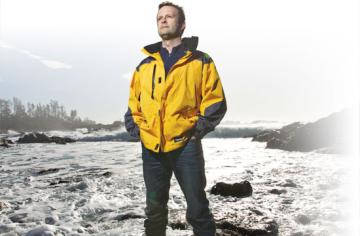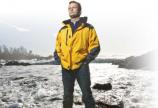UVic-led project assesses potential for wave energy
- Peigi McGillivray

Anyone who has visited the West Coast of Vancouver Island has seen the relentless power of the waves that crash onto our rocky shoreline. But exactly how much power is there in each wave? That’s the question that Dr. Brad Buckham, a UVic mechanical engineer and primary investigator on the West Coast Wave Collaboration Project, is working to answer.
“Ocean waves have a lot of potential as a source of clean, renewable energy, but before we can begin to harness that energy, we need to know a lot more about them,” says Buckham. “We need accurate, detailed data and reliable analytical tools—and up until this project, there simply haven't been any.”
The West Coast Wave Collaboration is an innovative project funded in part by the federal government that brings researchers, engineers, industry representatives, entrepreneurs and computer modelling experts together to collect and analyze wave energy data off the West Coast of Vancouver Island, from Brooks Peninsula near the north tip of the island to the Strait of Juan de Fuca.
“Two years ago, we put a buoy in the water off Ucluelet’s Amphitrite Point, where the waves are especially strong,” says Buckham. “The buoy collects and transmits high-resolution data every hour about winds, tidal action and waves. We also built a computer model that translates the raw data into highly accurate descriptions of wave heights, periods and directions nearer shore.”
Buckham's team, which includes several UVic graduate students, has had to overcome some setbacks. “The Pacific Ocean can be a pretty unforgiving place,” he says, “Something damaged the buoy a few months ago, and we had to bring it in for repairs. And it recently came free of its mooring.”
Buckham’s industry colleagues at Axys Technologies used the downtime to make modifications and improve the buoy. “These events are inevitable when the technology is so new and the deployment area so active,” says Buckham. “We look on them as chances to learn and improve.” The West Coast Wave Collaboration Project wraps up this spring, but it has already shown there is massive wave energy potential on Amphitrite Bank. The biggest wave recorded was a swell of 15 metres—about as high as a four-storey building. Buckham also points out that the real work has just begun.
“We need to turn this short-term project into a long-term initiative. We now have the expertise to run the technology and computer models, and are just beginning to analyze the data. Thanks to the robust tools we’ve developed through this project, we’re ready to build a solid base of knowledge for this emerging industry.”
Buckham’s leadership role puts UVic at the forefront of this clean energy sector. “We’re the first in the water with a coordinated computer modeling and field measurement program,” says Buckham. “And we want to stay in the lead, creating a knowledge base, working with the community, supporting industry and guiding policy development.”
With a coastline that is pounded year-round by the Pacific and a collaborative team with the right knowledge and expertise, Vancouver Island is poised to “catch the wave” of this emerging technology.
MORE ABOUT WAVE ENERGY
- Waves are caused by the wind blowing over the surface of the ocean. Wave energy has excellent potential off the British Columbia coast because it has unobscured swells generated in the north and south Pacific. “In the 19th century, that characteristic led to our coastline being called ‘the Graveyard of the Pacific’ for ships,” says Buckham. “Now we're trying to exploit it.”
- Over the course of a year, accumulated wave power in Vancouver Island’s offshore waters is estimated at 350,000 megawatt hours. Nearshore, the potential is about 175,000 mega-watt hours. The average household in BC Hydro’s service area uses about 1.1 megawatt hours a year.
- Brad Buckham is a member of UVic’s Institute for Integrated Energy Systems (IESVic), which is a national and international leader in research on sustainable energy technologies and systems.
- In large part due to IESVic research, UVic is the fifth most influential university in the world in the field of energy and fuels, according to Science Watch.

